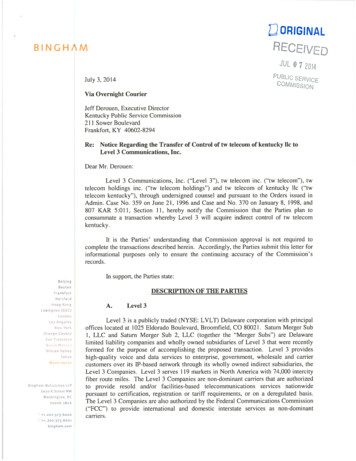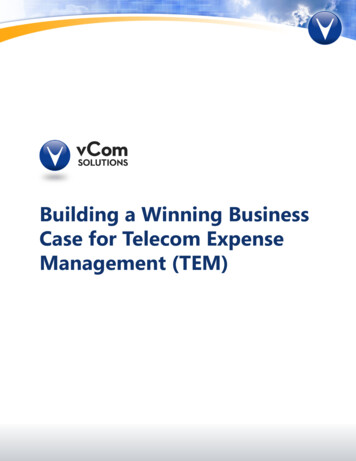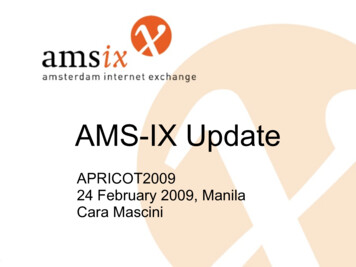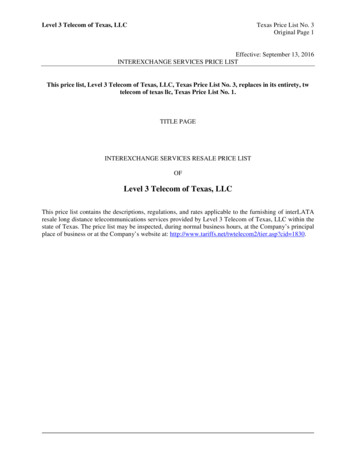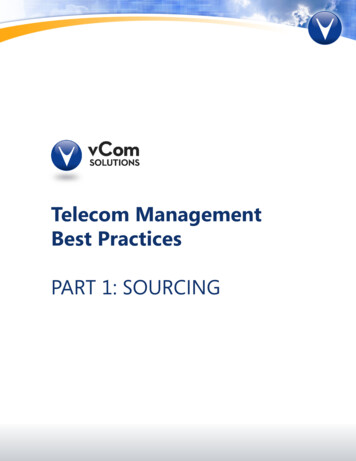
Transcription
Telecom ManagementBest PracticesPart 1: Sourcing
With telecom services continuing to account for 45% of annual ITSpend (Gartner Worldwide IT Spending Forecast Q4-2012), ITleaders must continue to focus on optimizing the managementof their telecom environment. In order to effectively manage anenterprise’s telecom environment, one must consider all aspectsof the telecom lifecycle. From sourcing and procurement, toservice, management and optimization and onto accountingand business intelligence; the IT department must ensure that itis optimizing each portion, and leveraging the right resources andtools, whether internal or external, to achieve the greatest value.The telecom lifecycle commences with sourcing. Selecting the right carrier, understanding the idiosyncrasies ofthe various technologies, and maintaining the fundamental role of technology in the business, are key elementsto ensuring effective management of the sourcing process. After you select your technology and identify yourcarrier options, negotiating a favorable contract, dedicating the right resources, and drafting comprehensiveproject plans, are essential elements of the sourcing process to ensure a successful telecom managementstrategy. This paper shares six steps to succeeding at telecom sourcing.1. Learn Your Carrier Options:Considering the critical nature of an enterprise’s network,an essential starting point of the sourcing process is to learnthe various carrier options. All carriers are not created equal.Tier 1 carriers offer the best peering, and by default providesimilar industry-standard Service Level Agreements (SLAs).They typically do not over-subscribe their networks, and theyprovide the greatest coverage. This becomes crucial whenlooking at a customer-managed VPN-based WAN solution,for example, where deploying a homogeneous network reducesthe challenges of overcoming the whims of the Internet. A Tier1 enabled network naturally offers better peering and reducesthe unpredictability of the Internet. On the other hand, Tier2 and some cablecos provide inexpensive alternative solutions.Although their networks may not provide the same SLAs orquality, they may prove sufficient for a small branch office or asa backup solution.vCom Solutions - Telecom Management Best Practices SourcingCustomer Example:One of our financial services customers,a global cash logistics organization, hadmultiple performance issues across their150-site MPLS network. The incumbentprovider was a Tier 2 carrier whosenetwork was not designed in a way towithstand fiber cuts. As a byproduct,our customer’s mission-critical cashmanagement centers suffered due tounpredictable outages. When managingan RFP and selecting a carrier for theirnext generation network, we ensured thatwe selected a carrier that would providesuch resiliency and leverage technologiesthat ensured automated re-routing.Page 1
2. Understand the Carrier Technologies:Network technologies are evolving at break-neck speed.In order to invest in the right and scalable technology foran enterprise network infrastructure, the IT leader mustunderstand the differences between the various technologies.For example, Ethernet comes in several flavors. Some, likeEthernet-over-Copper, are cost effective but have a limitedfootprint and are distance-sensitive. Conversely, many Tier 1and Tier 2 carriers have built their networks out and investedin “lighting up” strategic buildings with fiber to offer NativeEthernet. This provides an alternative to the LEC for the lastmile, and while it can prove more expensive, it is not distancesensitive and can prove essential for carrier redundancy andfault tolerance. Similarly, when considering a technologylike Enterprise SIP, only a few providers have invested inautomated failover across multiple strategically deployedSession Border Controllers, to offer true network faulttolerance. Staying abreast of the latest technologies and howthe carriers have deployed them is essential when consideringyour network architecture.Customer Example:One of our healthcare customers, aFortune 500 pharmaceutical company,came to us after struggling withperformance on their WAN. Despitehaving selected a Tier 1 carrier fortheir global MPLS network, theyhad overlooked the fact that severallocations were supported by Networkto-Network Interfaces (NNI), whichmeant that those sites experiencedperformance issues due to reliabilityissues across the secondary IP carriernetwork. When sourcing their newnetwork for them, we ensured that thechosen carrier offered global reachto their specific locations to eliminateany finger-pointing and create apredictable environment.Word of Caution:Many carriers’ sales compensation plans are positioned to promote a specific technology, particularly if the carrierneeds to recover its investment in such technology. It is incumbent upon the IT professional evaluating various solutionsto ensure that whatever he or she is considering is not simply being presented to meet a specific quota.3. Understand Your Organization’sBusiness NeedsWhile it’s beneficial to understand the technologiesthat are available in the marketplace and thedifferences between the various carrier options,one must apply that knowledge in the contextof the specific and unique business needs andrequirements. For example, a bank’s requirementsvCom Solutions - Telecom Management Best Practices SourcingPage 2
for security are very different from that of a retailchain or a legal practice. Equally important is a firmunderstanding of an organization’s requirements foruptime and redundancy, and tolerance for downtime. Those needs could be transitional, as the casewould be during a specific or unique project; orthey could be ongoing. The IT leaders must spendtime outlining an organization’s needs ahead ofembarking on a sourcing exercise, and they mustensure throughout the sourcing process that theyare reviewing the various technologies and carrieroptions in the context of the business needs.Customer Example:One of our large healthcare customers, a worldrenowned medical center, was migrating to newdata centers. Due to the mission-critical nature ofpatient applications, the new carrier architecturerequired 4 essential elements: 1) security, to complywith HIPAA requirements; 2) low latency, to supporta transactional environment; 3) high throughput, insupport of bandwidth-demanding applications likeRadiology; and 4) full carrier fault tolerance. Theresulting secure private network included 3 Tier-1carriers who provided access and route diversity,automated failover and low latency.Customer Example:In our first example, our cash logisticscustomer was in active acquisition mode,and as a byproduct, was consolidatingoffices across the U.S. We needed toensure that the contracts we negotiatedwith the carriers allowed for easyportability and waiver of early terminationfees on circuits at vacated locations.Due to the financial impact that servicedisruption would have on their business,we also had to be sure to negotiate arobust SLA, while also ensuring a solidbackup strategy.4. Negotiate Robust Contracts:The sourcing process requires the IT leadership to identifyspecific technologies and carriers. Next comes the contractphase. While many organizations focus on obviouselements in the contracts such as doing away with anever-green clause or ensuring the fairness of an assignmentclause, there are other elements that often go unnoticed.An example of that is portability, which becomes essentialwhen negotiating a multi-site implementation, especiallyif the business is anticipating office moves. SLAs are alsokey elements of a contract. When dealing with a dataservice like MPLS or Enterprise SIP for example, youmust ensure that you have a clear understanding of aprovider’s published SLAs for network availability, latency,jitter, packet loss, and mean time to repair. Most carrierspublish standard implementation intervals by service andservice type; some will provide SLA credits for missingthose published installation intervals. You must also have afundamental understanding of miscellaneous chargesvCom Solutions - Telecom Management Best Practices SourcingPage 3
(supplementary fees, inside wiring fees, hardware configuration fees, and re-dispatch fees to name a few) to eliminateany surprises once the deployment process commences. Other important factors to negotiate include overlapin-billing credits when migrating from an existing carrier network, dispute windows, and cleft-based industryadjustments, when negotiating longer term contracts.5. Ensure Adequate Implementation SupportA part of selecting the right carrier for large projects is ensuringthe commitment of the right and dedicated resources to executethe project. Dedicated project management and engineeringpersonnel are essential resources to ensure the timely and effectivedeployment of the new carrier technologies. The project managerwill oversee the carrier responsibilities, manage deliverables, and workwith local contacts to coordinate delivery and deployment of the newservices. A design engineer will put together network diagrams, scope ofwork documents and review testing plans with the IT team to facilitate awell-planned migration strategy. An implementation engineer will work withthe carrier during the testing and follow a stringent process to ensure the propertesting of the new technology and services. For example, during enterprise SIP implementations, testingE911 from each location serviced by the SIP Trunking environment is an essential step that many engineersomit, and can subsequently have grave business ramifications if it proves problematic or goes uncorrected.6. Have a Solid Project PlanEvery project must start with a clear project plan that incorporates a well-thought out scope of work withclear objectives, responsibilities, timelines and expectations. The project plan must also contain a well-definedtesting plan that provides a clear cut-over strategy. The IT leaders must ensure that the carrier will be able toexecute such a project plan and dedicate the necessary resources to ensure its success.Many IT organizations attribute their success in managing complex migrations to their technical knowledge,the experience on their teams, and their wealth of technical tools. There’s no doubt that these factors areimportant to any organization’s success. When it comes to managing a complex transition, however, successhinges more on the discipline to implement well-defined and consistent project management principles, andensuring that everyone involved, including the carrier resources, are following those principles.vCom Solutions - Telecom Management Best Practices SourcingPage 4
Effective management of the sourcing process eludes many organizations, which results ina suboptimal and more complex telecom environment to manage, while leaving much to bedesired for ensuring the organization’s best interests. Leveraging the right experience andmethodical practices will help the IT leaders of the organization set the stage for a properlymanaged telecom lifecycle. Enterprise organizations have the option of hiring thoseresources or partnering with a Telecom Lifecycle Management firm that has the expertiseand tools to effectively manage this important process. While there are many professionalservices organizations that offer such a service for a fee, the new model of TelecomManagement as a Service (TMaaS) presents an appealing value proposition, as the cost togain such expertise is heavily subsidized, as is the cost for the tools necessary during thenext steps of the telecom lifecycle.ABOUT VCOM SOLUTIONSvCom Solutions revolutionizes the way enterprises manage their entire telecom lifecycle. vCom customersgain control over inventory, expenses and carrier relationships, achieving better business intelligence that drivesprofitability. vCom’s Telecom Management as a Service (TMaaS) solution includes a suite of cloud-basedtelecom management software tools, complemented by a full portfolio of professional services.For more information, visit www.vcomsolutions.comHeadquarters12657 Alcosta Blvd, Suite 418 Main: 800-804-VCOMSan Ramon, CA 94583 Direct: 925-244-1800Page 5
managed telecom lifecycle. Enterprise organizations have the option of hiring those resources or partnering with a Telecom Lifecycle Management firm that has the expertise and tools to effectively manage this important process. While there are many professional services organizations that offer such a service for a fee, the new model of Telecom
